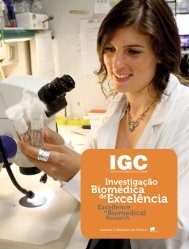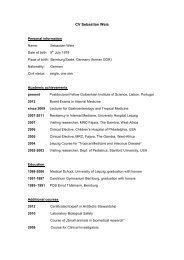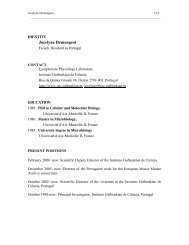organisation - the Instituto Gulbenkian de Ciência
organisation - the Instituto Gulbenkian de Ciência
organisation - the Instituto Gulbenkian de Ciência
- No tags were found...
You also want an ePaper? Increase the reach of your titles
YUMPU automatically turns print PDFs into web optimized ePapers that Google loves.
ORGANOGENESIS<br />
Joaquín Rodríguez León Principal Investigator<br />
PhD in Biology, University of Extremadura, Spain, 2000<br />
Principal Investigator at <strong>the</strong> IGC since 2008<br />
Our group focuses on <strong>the</strong> study of <strong>the</strong> cellular and molecular mechanisms controlling<br />
limb <strong>de</strong>velopment and fin regeneration. We are trying to un<strong>de</strong>rstand<br />
how <strong>the</strong> main signalling centre in limb <strong>de</strong>velopment, <strong>the</strong> Apical Ecto<strong>de</strong>rmal<br />
Ridge (AER), is established and maintained through <strong>de</strong>velopment and how different<br />
molecules, namely those related to stemness, are involved in <strong>the</strong>se processes.<br />
Also, we have <strong>de</strong>veloped a line of research directed to <strong>de</strong>pict how ion<br />
dynamics can control limb <strong>de</strong>velopment, digit differentiation and fin regeneration.<br />
In <strong>the</strong>se studies we use <strong>the</strong> chicken and zebrafish embryos as well as adult<br />
zebrafish as animal mo<strong>de</strong>ls.<br />
ROLE OF STEMNESS GENES DURING FORMATION OF COMPLEX ORGANS<br />
This project is framed into a general line of work in our lab that focuses on<br />
<strong>the</strong> study of different genes that are involved in <strong>the</strong> maintenance of stemness<br />
in vitro, and <strong>the</strong>ir in vivo role during <strong>de</strong>velopment of complex organs. We are<br />
studying how oct4 plays a role in <strong>the</strong> formation of limbs during vertebrate<br />
<strong>de</strong>velopment. Our main objective is to unveil how oct4 controls <strong>the</strong> activity of<br />
a signalling centre essential for limb formation, <strong>the</strong> Apical Ecto<strong>de</strong>rmal Ridge<br />
(AER). The aims of this project are:<br />
GROUP MEMBERS<br />
Ana Catarina Certal Afonso (Post-doc, left September)<br />
Rui Castanhinha (PhD Stu<strong>de</strong>nt)<br />
Joana Monteiro (External PhD stu<strong>de</strong>nt)<br />
Rita Felix (Masters Stu<strong>de</strong>nt)<br />
Ana Rita Aires (Research Technician)<br />
COLLABORATORS<br />
Yolanda Gañán Presmanes (University of Extremadura, Spain)<br />
Domingo Macías Rodríguez (University of Extremadura, Spain)<br />
Michael Levin (Tufts University, USA)<br />
FUNDING<br />
Fundação para a Ciência e a Tecnologia (FCT), Portugal<br />
PUBLIC ENGAGEMENT IN SCIENCE<br />
Talk for school stu<strong>de</strong>nts, Colegio Arias Montano, Badajoz, Spain (April)<br />
Talk for school stu<strong>de</strong>nts, Escola Santo António e Escola António Aleixo,<br />
Figueira <strong>de</strong> Castelo Rodrigo, Portugal (November)<br />
1. To characterise oct4 expression during limb bud <strong>de</strong>velopment;<br />
2. To characterise <strong>the</strong> dynamics of proliferation versus apoptosis in <strong>the</strong> Apical<br />
Ecto<strong>de</strong>rmal Ridge during limb bud <strong>de</strong>velopment;<br />
3. To un<strong>de</strong>rstand <strong>the</strong> role of oct4 during limb bud <strong>de</strong>velopment and its implication<br />
in <strong>the</strong> maintenance of AER structure, function and cell behaviour;<br />
4. To correlate <strong>the</strong> activity of FGFs, Wnts and RA and <strong>the</strong> control of oct4<br />
expression with <strong>the</strong> AER structure, function and cell behaviour.<br />
We have found that Wnts and Fgfs control and maintain oct4 expression in <strong>the</strong> proliferative<br />
areas of <strong>the</strong> AER. On <strong>the</strong> contrary, BMPs and Retinoic Acid signaling act<br />
as negative factors that abolish oct4 expression in <strong>the</strong> apoptotic areas of <strong>the</strong> AER.<br />
We have also performed experiments involving pulses of BrdU and <strong>the</strong>se manipulations<br />
show that proliferative cells in <strong>the</strong> dorsal and ventral si<strong>de</strong>s of <strong>the</strong> AER will<br />
migrate towards its centre and will die by apoptosis. Manuscript is in preparation.<br />
ION DYNAMICS DURING FIN REGENERATION<br />
With this project we intend to assess <strong>the</strong> role of electric currents as coordinating<br />
signals during <strong>the</strong> re-establishment of <strong>the</strong> P-D axis after amputation of<br />
adult vertebrate appendages. We want to extend <strong>the</strong> current knowledge on <strong>the</strong><br />
molecular and cellular bases of bioelectric signals as well as <strong>the</strong> mechanisms<br />
that convert <strong>the</strong>m into cellular responses. The aims of this project are:<br />
Limb bud after oct4 overexpression and double in situ for fgf8 (orange) and msx-1<br />
(blue).<br />
1. To <strong>de</strong>scribe <strong>the</strong> ion composition of electric currents associated with <strong>the</strong> regeneration<br />
of caudal fins and to generate a spatial-temporal map of <strong>the</strong> intracellular<br />
and extracellular dynamics of particular ion species during regeneration;<br />
2. To unveil <strong>the</strong> molecular and cellular bases of ion dynamics associated with<br />
regeneration;<br />
3. To un<strong>de</strong>rstand <strong>the</strong> role of specific ion transporters in <strong>the</strong> regeneration<br />
mechanism;<br />
4. To establish a link between ion dynamics and known molecular pathways<br />
involved in <strong>the</strong> regeneration process.<br />
We have <strong>de</strong>monstrated that during regeneration, a proton outward flux gradient is<br />
established along <strong>the</strong> proximo-distal axis. Moreover, we have i<strong>de</strong>ntified <strong>the</strong> V-AT-<br />
Pase as <strong>the</strong> most likely molecular source that triggers <strong>the</strong> <strong>de</strong>tected regenerationspecific<br />
H+ efflux. Inhibition of this ion pump <strong>de</strong>creases regeneration rate. Hence,<br />
we suggest that V-ATPase mediated proton flux in involved in <strong>the</strong> spatial coordination<br />
of genes that will dictate <strong>the</strong> position-<strong>de</strong>pen<strong>de</strong>nt rate of regeneration.<br />
Scanning electron microscopy micrograph showing <strong>the</strong> surface of <strong>the</strong> regenerating<br />
blastema in a zebrafish caudal fin 6 hours after amputation.<br />
IGC ANNUAL REPORT ‘11<br />
RESEARCH GROUPS<br />
46






